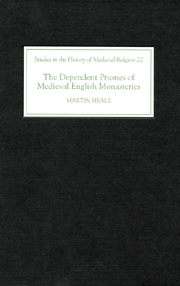Book contents
- Frontmatter
- Contents
- List of Figures and Tables
- Dedication
- Acknowledgements
- Abbreviations
- Maps: The Dependent Priories of the Monasteries of Medieval England (England and Wales)
- Introduction
- Part I The Dependent Priory as Daughter House
- Part II The Dependent Priory as Small Monastery
- Appendices
- Select Bibliography
- Index
- Other Volumes in Studies in the History of Medieval Religion
Introduction
Published online by Cambridge University Press: 12 September 2012
- Frontmatter
- Contents
- List of Figures and Tables
- Dedication
- Acknowledgements
- Abbreviations
- Maps: The Dependent Priories of the Monasteries of Medieval England (England and Wales)
- Introduction
- Part I The Dependent Priory as Daughter House
- Part II The Dependent Priory as Small Monastery
- Appendices
- Select Bibliography
- Index
- Other Volumes in Studies in the History of Medieval Religion
Summary
Of all the groups of religious houses in medieval England and Wales, the dependent priories of English monasteries are the least studied. This neglect can largely be attributed to the widespread belief that small daughter houses were unimportant appendages to their parent abbeys with no independent history of their own and often mere instruments of estate management. The more exotic ‘alien priories’, the satellites of French abbeys founded in England after the Conquest, have been able to attract considerable attention, primarily because of their dramatic suppression over a century before the general Dissolution; but English dependencies have been much less fortunate. Yet a glance at the statistics compiled by Professor David Knowles and R. Neville Hadcock reveals that the cells of English abbeys and priories were an important part of the monastic landscape of medieval England and Wales. About eighty Benedictine and thirty-four Augustinian daughter houses were established between the Conquest and 1250 in Britain, together with eight small cells in Ireland and Evesham Abbey's dependency of Odense in Denmark. Although thirty-one or so of these houses had lapsed, or had ceased to be cells, by the end of the thirteenth century, another nineteen were later founded or acquired as satellites by English abbeys. Put another way, of about 130 denizen Benedictine houses in fifteenth-century England and Wales, thirty-two possessed at least one dependency and a further seventy-one were themselves satellites.
- Type
- Chapter
- Information
- Publisher: Boydell & BrewerPrint publication year: 2004



